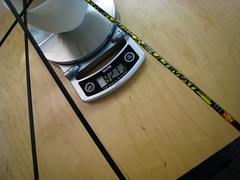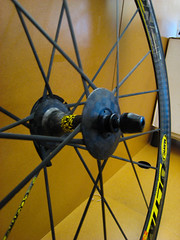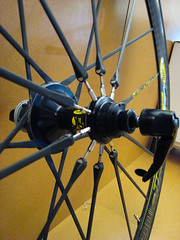The short version: holy crap!
The longer version: The boom in carbon wheels has been massive over the past few years. In the professional peleton, nearly every rider is on carbon hoops, even in the most demanding races like Paris Roubaix or the Tour of Flanders. Of course, those guys have the luxury of a team car carrying dozens of spares right behind them, just in case something goes wrong.
The other car there is Mavic's famous neural support car. The French wheelmaker had been conspicious in its absence from the carbon market, with just a couple of models out there, some of which use carbon as a non-structrual faring. But they've entered the arena in a big way with these wheels, which are fully carbon, from the rims to the spokes to the hubs.
I had a chance to ride the first pair of the wheels in North America over two weeks -- look for pictures of them in Wired magazine soon. But I wanted to post some snaps, and some impressions.

That's the front wheels on our scale, with a Hutchinson tubular (yes, they're tubulars) and the skewer installed. That's 821 grams out the door. Woot, as they say.

That's the rear wheel, with tire and skewer, but no cassette. Just over a kilogram, at 1006 grams.
So what does it mean when your entire wheelset is under two kilos, including the tires? It means that they spin up amazingly quickly. The biggest difference I felt riding these over other wheels I've ridden was in acceleration.
You know when you're on rolling terrain, and you look to stomp up a hill in a big gear, trying to keep your momentum going? That moment when you stand and pound on the pedals is just silly with these -- they just seem to rocket forward when you apply the power.
How do they keep the weight down? A couple of tricks:
The front wheel is all one piece, like Lightweights wheels. The spokes are molded directly into the rim, and then into the carbon hub. There's no adjustment, and no truing available. That means that the mold better be damn straight, and Mavic's seemed true and perfect.
In back, there is some adjustment available -- nipples molded into the non-drive side allow the wheel's dish to be tweaked. Again, the models I had were just fine as delivered, but it's interesting that they've made some provision for tweaking.
Braking performance on carbon wheels is a fraught topic -- no matter what steps you take, a carbon wheel, right now, isn't going to stop as well as an aluminum rim. I installed Zipp's carbon pads on the bikes Campagnolo Record brakes, and was reasonably pleased with the braking. One ride had a good bit of mist during it, and stopping power was fine. There was the usual squealing that one gets with carbon rims.
Now, a 2 kg set of wheels that retails for $2,750 (Oh, I didn't mention that before?) isn't for everyone. These are definitely racing wheels, and are the stiffest wheels I've ever ridden. Even though they're carbon, they're not absorbing vibration. The goal of these is to transmit power from rider to road, and they do that exceptionally well.
That pricetag is pretty tough, as well, although its much less than the very comparable Lightweights. Mavic also has a wheel protection plan that will pay for replacement wheels if there's damage -- that seems like a well-spent $220 in this case.
Those yellow cars following pro races are a symbol of quality and reliability, and Mavic's been working on this wheelset for several years. They're very confident in them, and after my time on them, I am as well. Suffice it to say that as I box them up to return to Mavic, I'm wondering just how I can go back to regular old wheels.

